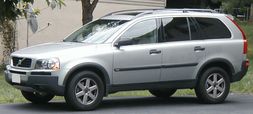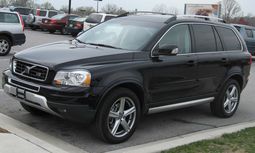The History Of Volvo XC90

The Volvo XC90 is a mid-size luxury crossover SUV produced by Volvo Cars since it was unveiled at the Detroit Motor Show 2002. It is based on the P2 platform, shared with the first generation Volvo S80 and other large Volvo cars. As Volvo's top-selling vehicle in the United States,the XC90 is also Volvo's best selling model worldwide with 85,994 cars sold in 2005.
At its launch as a 2003 model, it was presented with a choice of two models, the 2.5T and the T6. The 2.5T was the entry level version and offered a 2.5L 20 valve turbocharged inline 5 engine putting out 205hp (153kW; 208PS) and 236ft·lbf (320N·m) mated to an Aisin co-developed AW55-50/ 51 5 speed automatic. The T6 offered a 2.9L 24 valve twin turbocharged inline 6 with 268hp (200kW; 272PS) and 280ft·lbf (380N·m) mated to a GM-sourced, Volvo modified 4T65EV/ GT 4 speed automatic. While the 2.5T came standard with front wheel drive, a Haldex Traction all wheel drive system was optional. The T6 was offered only with the AWD system.
A new Ford/ Yamaha V8 engine was added in 2005. This 4.4L Ford V8 engine produces 311hp (232kW; 315PS) and 325ft·lbf (441N·m) of torque. The XC90 V8 will be priced at just over US$45,000 and it is expected that more than 15,000 would be sold per year.
The XC90 won the North American Car of the Year award and Motor Trend magazine's Sport/ Utility of the Year for 2003.
The XC90 was updated for 2007 with a restyled front and rear and a revised interior. The 235hp (175kW; 238PS) 3.2 L SI6 straight-6 engine replaced the 208hp (155kW; 211PS) B524T2 straight-5 in the base model for the US market. The 2007 XC90 debuted in April 2006 at the New York Auto Show.
The XC90 is produced at Volvo's Torslanda Plant (Torslandaverken) in Sweden.
The XC90 is also known for the world's best performance in the SUV roll over test, as many other premium brands neglect to test this feature on their models.[citation needed] The Volvo XC90 front end is specifically designed to absorb frontal impacts and also deflect any pedestrians up on to the hood of the vehicle rather than underneath the bonnet. Volvo has patented the unique frontal structure that has renowned crumple zones, and a pre-determined positions for the engine and other ancillaries during a frontal impact.[citation needed]
The XC90's roof is reinforced with ultra high strength steel to help prevent a collapse in the passenger cavity in the event of a roll over. This Volvo system is called ROPS, and is closely associated with the RSC, DSTC, and SIPS systems of Volvo to prevent and ultimately minimize effects of a pending accident.
This Volvo SUV has been designed on the rear end to absorb impact energy, but the occupants are also protected by one of the world's most advanced whiplash protection systems. This Volvo WHIPS system cradles the entire body of the occupants when jolted in a rear end collision.
The XC90 has scored the highest rating of "Good" in the IIHS crash test; notably the rear impact, side impact, and roll over; for numerous years since its debut and most recently on.[citation needed]
[original research?]
Many owners of the T6 variant have reported very early transmission failures, many before 60,000miles (97,000km). Some owners have reportedly gone through two transmissions in that time. The GM-sourced 4T65EV/ GT transmissions usually show symptoms of failure by suddenly slipping while in gear. There has not been a recall for this issue, but the faults are widely known and documented. Various causes have been claimed, ranging from engine coolant entering the transmission fluid to problems arising from Volvo's modification of the original GM valve body unit inside the transmission, but none have been substantiated.
At the end of July 2007, Volvo Car Corp. announced the recall of 42,211 2005 year XC90's in order to check their batteries to avoid the risk of an internal short circuit and fire. The vehicles were manufactured in the Swedish Torslandaverken between June 7, 2004 and May 13, 2005. The recall only applies to cars in the U.S. and Canada. There have been no reports of short circuiting in the vehicles.
The updated XC90 that was scheduled for 2010 introduction, has been canceled. Instead, the current model will undergo a facelift that will keep it on the market until 2012. Volvo has stated that the second generation XC90 is not cancelled altogether, as rumored, but its introduction could be delayed. The next generation was sent back to the engineering board to improve the vehicles weight, handling, and most important of all, its fuel efficiency.The next generation is expected to grow slightly in size to better compete with the likes of the BMW X5. Volvo engineers will improve on engine fuel efficiency through the use of hybrid technology and other innovations such as start stop technology. The 2012 XC90 will borrow heavily from the design of the current XC60 but will be better packaged for luxury consumers. The vehicle will feature a larger third row seat and a panoramic sun roof as seen on the Volvo XC60.
From Wikipedia, the free encyclopedia
More About Volvo XC90


|